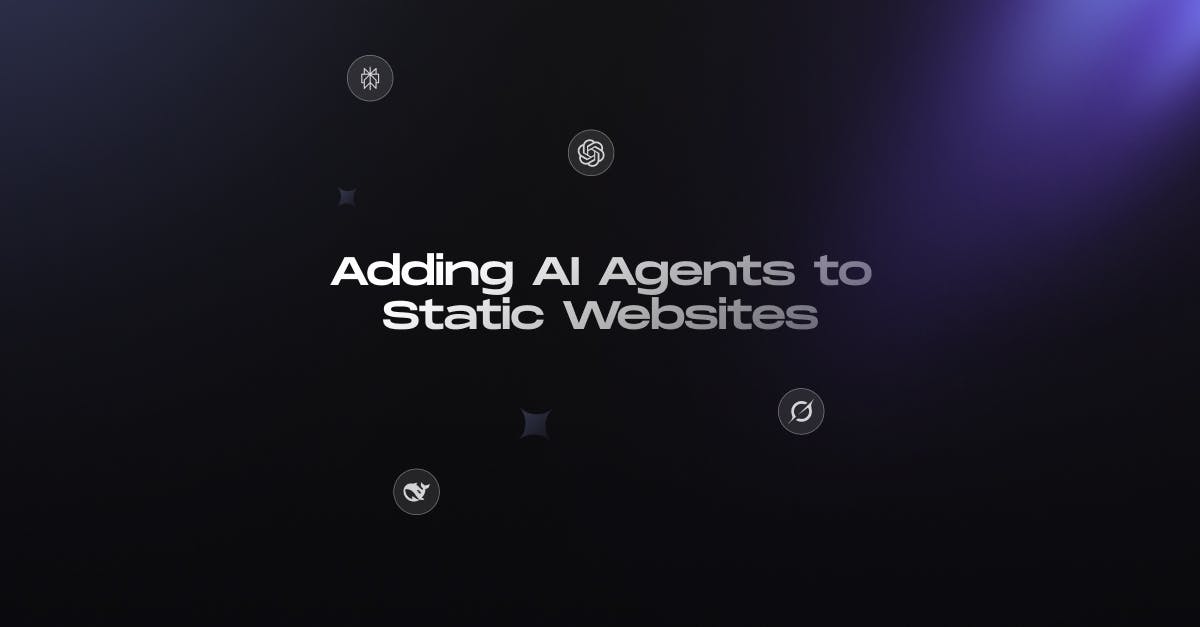October 13, 2025
Adding AI Agents to Static Websites for Smarter Customer Experiences

Md. Saad

Static sites are fast. They load in milliseconds, rank well on search engines, and handle traffic spikes effortlessly.
However, here's the catch: they lack built-in user personalisation, smart recommendations, and conversational support.
That's where AI agents come in.
Businesses that hire expert AI developers can now add intelligent features, such as AI-assisted chatbots, AI voice assistants, and recommendation engines, all trained on the website's proprietary data and content, without compromising performance. The trick is doing it right, and this guide shows how.

SOURCE: Gemini
What Are AI Agents, and Why Add Them to Static Sites?
AI agents are autonomous programs designed to perform specific tasks, such as answering customer questions, analyzing user behavior, or providing personalized recommendations based on a unique dataset. Unlike traditional backend systems, these agents operate on the client side or via serverless APIs, introducing dynamic features into static architectures.
AI agents can fill the interactivity gap that static sites naturally have. When added to JAMStack sites, they create experiences that feel both fast and smart. Consider:
- Instant support without live agents. Chatbots handle common questions 24/7, keeping frustration low and satisfaction high, thanks to ChatGPT-like technology.
- Hands-free navigation. AI voice assistants make websites accessible and easier to use on mobile devices.
- Personalized discovery. Recommendation engines guide users to relevant content they might have missed, reducing bounce rates and increasing time on site.
- Page summaries. Helping users to save time and get what they need on your website quickly.
With AI agents, companies can address a core problem plaguing user experience: churn rate or abandonment.
In fact, Forbes reports that 88% of users never revisit a website after a single negative interaction. And according to Forrester Research, fixing this can do wonders, indicating that a well-designed website UX can boost conversions by up to 200%!
AI-Powered Chatbots
Chatbots are the most common AI agents on websites. They answer questions, guide users through navigation, and handle support requests without human intervention.
What Chatbots Are Made Of
- A natural language processing (NLP) model that understands user queries
- An intent recognition system that figures out what users actually want
- Response generator that provides appropriate answers
- Knowledge base containing FAQs, documentation, or product information
- Frontend widget that displays the chat interface
Workflow for Adding Chatbots to Static Sites
- Choose your approach: You can use pre-built services like Dialogflow or ChatGPT API, or hire dedicated AI developers to build a custom chatbot trained on your specific content.
- Prepare your knowledge base: Feed your chatbot the information it needs. This includes FAQs, product specs, pricing details, and common user questions.
- Integrate the chat widget: Add a JavaScript snippet to your static site that loads the chat interface.
- Connect to your AI backend: Set up API endpoints that handle user messages. When someone types a question, the frontend sends it to your AI service, which processes it and returns an answer.
Real-Life Implementation Example
A documentation site built with Hugo adds a chatbot. A user types "How do I install this on Ubuntu?" The chatbot's NLP model parses the query, searches its knowledge base, and responds instantly with installation commands. The site remains static while the AI agent runs via an API.
Voice Assistants
Voice assistants let users navigate or search your site hands-free. They're especially valuable for accessibility and mobile experiences where typing is inconvenient.
What Voice Assistants Are Made Of
- A speech recognition engine that converts voice to text
- Natural language understanding (NLU) that interprets the text
- Command processor that executes actions based on intent
- A text-to-speech (TTS) system that provides audio responses
- Microphone integration in the browser
Workflow for Adding Voice Assistants to Static Sites
- Set up speech recognition: Use the Web Speech API for browser-based recognition, or integrate services like Google Cloud Speech-to-Text.
- Process the voice command: Send the transcribed text to your AI backend. The NLU model figures out what action the user wants.
- Execute the command: Based on the intent, your JavaScript code performs the action.
Real-Life Implementation Example
An e-commerce site selling sports equipment adds voice search. A user taps the microphone and says, "Do you have running shoes in size 10?" The AI processes it, searches the catalog, and the TTS responds: "Yes, we have three running shoes in size 10. The top result is the Trail Runner Pro at $129."
Recommendation Engines
Recommendation engines analyze user behavior and suggest relevant content or products. They make browsing feel personalized rather than generic.
What Recommendation Engines are Made of
- Data collection layer that tracks user behavior (pages viewed, time spent, clicks)
- Machine learning model that identifies patterns and predicts preferences
- Filtering algorithm (collaborative, content-based, or hybrid)
- API endpoint that serves recommendations in real-time
- Frontend component that displays suggestions
Workflow for Adding Recommendation Engines to Static Sites
- Collect behavioral data: Use analytics tools or custom JavaScript to track what users do on your site. Store this data in a database or send it to a machine learning platform.
- Train your recommendation model: If you hire artificial intelligence developers, they'll build a model that learns from user behavior patterns.
- Deploy the model to an edge function: Host your recommendation logic on edge servers for fast response times. When a user loads a page, the edge function receives their browsing context and returns personalized suggestions.
Real-Life Implementation Example
A tech blog built with Jekyll shows recommended articles at the end of each post. When a user finishes reading about Python web scraping, JavaScript sends the article ID to an edge function. The recommendation engine, trained on user behavior patterns, instantly returns three related articles: data visualization, API integration, and web automation.
Keep It Fast, Keep It Smart
Static sites don’t have to mean static experiences. With the right AI agents, they can feel as interactive and personalized as any dynamic platform while maintaining their speed and security advantages.
Start small: hire AI developers to create a chatbot or a simple recommendation feature first, observe how users respond, and then build upon it.
Your customers want speed. And they also want smart sites. With AI agents on JAMstack, you can give them both.
At StaticMania, we specialize in building high-performance static & JAMstack websites enhanced with AI-driven features. Our expert developers integrate tools such as chatbots, voice assistants, and recommendation systems, making your site not only fast and secure but also intelligent and human-like.
If you’re ready to transform your static website into an intelligent experience that engages and converts, StaticMania’s AI-powered development team is here to bring your vision to life.

